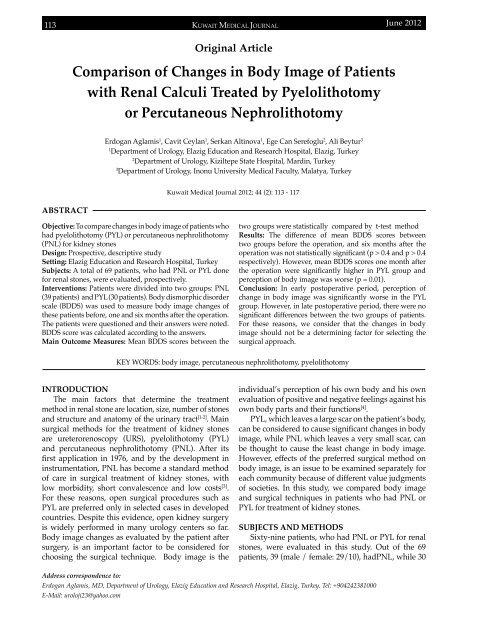Vol 44 # 2 June 2012 - Kma.org.kw
Vol 44 # 2 June 2012 - Kma.org.kw
Vol 44 # 2 June 2012 - Kma.org.kw
Create successful ePaper yourself
Turn your PDF publications into a flip-book with our unique Google optimized e-Paper software.
113<br />
KUWAIT MEDICAL JOURNAL<br />
<strong>June</strong> <strong>2012</strong><br />
Original Article<br />
Comparison of Changes in Body Image of Patients<br />
with Renal Calculi Treated by Pyelolithotomy<br />
or Percutaneous Nephrolithotomy<br />
Erdogan Aglamis 1 , Cavit Ceylan 1 , Serkan Altinova 1 , Ege Can Serefoglu 2 , Ali Beytur 3<br />
1<br />
Department of Urology, Elazig Education and Research Hospital, Elazig, Turkey<br />
2<br />
Department of Urology, Kiziltepe State Hospital, Mardin, Turkey<br />
3<br />
Department of Urology, Inonu University Medical Faculty, Malatya, Turkey<br />
ABSTRACT<br />
Kuwait Medical Journal <strong>2012</strong>; <strong>44</strong> (2): 113 - 117<br />
Objective: To compare changes in body image of patients who<br />
had pyelolithotomy (PYL) or percutaneous nephrolithotomy<br />
(PNL) for kidney stones<br />
Design: Prospective, descriptive study<br />
Setting: Elazig Education and Research Hospital, Turkey<br />
Subjects: A total of 69 patients, who had PNL or PYL done<br />
for renal stones, were evaluated, prospectively.<br />
Interventions: Patients were divided into two groups: PNL<br />
(39 patients) and PYL (30 patients). Body dismorphic disorder<br />
scale (BDDS) was used to measure body image changes of<br />
these patients before, one and six months after the operation.<br />
The patients were questioned and their answers were noted.<br />
BDDS score was calculated according to the answers.<br />
Main Outcome Measures: Mean BDDS scores between the<br />
two groups were statistically compared by t-test method<br />
Results: The difference of mean BDDS scores between<br />
two groups before the operation, and six months after the<br />
operation was not statistically significant (p > 0.4 and p > 0.4<br />
respectively). However, mean BDDS scores one month after<br />
the operation were significantly higher in PYL group and<br />
perception of body image was worse (p = 0.01).<br />
Conclusion: In early postoperative period, perception of<br />
change in body image was significantly worse in the PYL<br />
group. However, in late postoperative period, there were no<br />
significant differences between the two groups of patients.<br />
For these reasons, we consider that the changes in body<br />
image should not be a determining factor for selecting the<br />
surgical approach.<br />
KEY WORDS: body image, percutaneous nephrolithotomy, pyelolithotomy<br />
INTRODUCTION<br />
The main factors that determine the treatment<br />
method in renal stone are location, size, number of stones<br />
and structure and anatomy of the urinary tract [1-2] . Main<br />
surgical methods for the treatment of kidney stones<br />
are ureterorenoscopy (URS), pyelolithotomy (PYL)<br />
and percutaneous nephrolithotomy (PNL). After its<br />
first application in 1976, and by the development in<br />
instrumentation, PNL has become a standard method<br />
of care in surgical treatment of kidney stones, with<br />
low morbidity, short convalescence and low costs [3] .<br />
For these reasons, open surgical procedures such as<br />
PYL are preferred only in selected cases in developed<br />
countries. Despite this evidence, open kidney surgery<br />
is widely performed in many urology centers so far.<br />
Body image changes as evaluated by the patient after<br />
surgery, is an important factor to be considered for<br />
choosing the surgical technique. Body image is the<br />
individual’s perception of his own body and his own<br />
evaluation of positive and negative feelings against his<br />
own body parts and their functions [4] .<br />
PYL, which leaves a large scar on the patient’s body,<br />
can be considered to cause significant changes in body<br />
image, while PNL which leaves a very small scar, can<br />
be thought to cause the least change in body image.<br />
However, effects of the preferred surgical method on<br />
body image, is an issue to be examined separately for<br />
each community because of different value judgments<br />
of societies. In this study, we compared body image<br />
and surgical techniques in patients who had PNL or<br />
PYL for treatment of kidney stones.<br />
SUBJECTS AND METHODS<br />
Sixty-nine patients, who had PNL or PYL for renal<br />
stones, were evaluated in this study. Out of the 69<br />
patients, 39 (male / female: 29/10), hadPNL, while 30<br />
Address correspondence to:<br />
Erdogan Aglamis, MD, Department of Urology, Elazig Education and Research Hospital, Elazig, Turkey. Tel: +904242381000<br />
E-Mail: uroloji23@yahoo.com
















